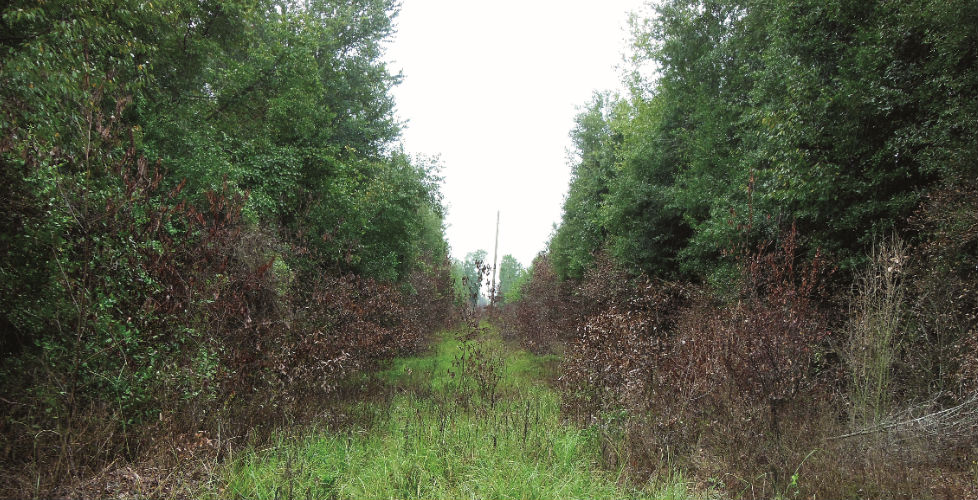In recent years, there’s been a gradual shift away from predominantly nonselective management methods to more selective methods within rights-of-way (ROW) maintenance programs. And for good reason. While nonselective treatments remain effective in managing unwanted weeds, trees and brush that can threaten system reliability, using only nonselective treatments keep vegetation managers from realizing what could be significant improvements to their VM programs. The opportunity for improvement stems from the increased presence of beneficial plant species, like grasses, which can serve a greater purpose than just aesthetics on ROWs.
A more progressive approach follows the principles of integrated vegetation management (IVM). IVM is best described as using a combination of herbicides and/or mechanical treatments to initially control incompatible trees on ROWs. The end goal is to create a dense cover of desirable or compatible plant species to then serve to inhibit reinvasion of incompatible species. That can only be achieved by taking a selective vegetation management approach. This approach has two distinct layers:
- The method(s) chosen to manage incompatible vegetation. Here, many utilities have transitioned from broadcast herbicide applications to more targeted application techniques like low-volume foliar or even individual plant treatments (IPTs).
- The herbicides chosen for applications. This is oftentimes where the opportunity is missed. That’s because even as many utilities have begun moving to more selective application methods, they’ve done so using herbicides that are nonselective
Choosing nonselective herbicides can result in significant site disturbance and elimination of compatible plant species — even when they are applied using more selective treatment methods. This is especially true when targeting very concentrated thickets of brush or when incompatible stem densities are relatively high. This is counter to the goals of IVM.
When you instead partner selective herbicides with targeted application methods, you create the best opportunity to establish maximum levels of desirable, low-growing plant species like grasses, forbs and shrubs on the use sites you manage. This allows for a sustainable and stable community of compatible plants that works to deter establishment of incompatible vegetation. In addition to lowering weed pressure, transitioning areas like ROW corridors to more desirable plant cover offers significant program enhancements, including:
- A better return on investment with reduced maintenance costs over time. Preserving grasses, forbs and other low-growing herbaceous species, especially on rights-of-way, serves as an effective natural defense against incompatible trees and woody brush. Ultimately, vegetation managers will need to use less herbicides over time for maintenance, while at the same time increasing soil stabilization.
- Supported by industry standards and best management practices. The practice of selective vegetation management using herbicides has been adopted as an industry standard and best management practice by leading utility industry associations, such as the Tree Care Industry Association and the International Society of Arborists.
- Demonstrating intentional management reduces public scrutiny. Maintaining as much compatible vegetation as possible after an appropriate herbicide application can positively influence public opinions and sentiment. Demonstrating a high level of selectivity in the removal of incompatible vegetation can result in fewer complaints from landowners and the public.
- Improved habitat and biodiversity. More than 60 years of industry research as part of the Pennsylvania State Gamelands 33 and Greenlane Research & Development projects have proven that using selective VM greatly improves ROW habitat and biodiversity. The increased presence of native forbs and shrubs makes land very attractive to critical pollinator species and other important wildlife.
- Greater freedom to operate. When managed lands like ROWs cross through more sensitive areas, such as U.S. Forest Service lands or municipalities, it can be challenging to gain the necessary approvals to treat them. When vegetation managers are able to demonstrate how their management approach results in habitat improvement, it can help open doors.

It’s important to choose a selective herbicide mix best-suited to achieving IVM goals. One particularly effective mix consists of Vastlan® herbicide at 2.25% combined with Milestone® herbicide at 0.33%, along with a surfactant at 1%. Vastlan provides control of a broad spectrum of conifers and hardwood species like oaks, sweetgum, maple and hickory. Milestone is included to enhance control on pines and select hardwood species, with added invasive weed control. Even at very low use rates, the mix offers enhanced brush control, with excellent exhibited tolerance of desirable vegetation.
An infusion of selectivity could be just what your VM program needs to better achieve its goals.
™®Trademarks of Dow AgroSciences, DuPont or Pioneer, and their affiliated companies or their respective owners. When treating areas in and around roadside or utility rights-of-way that are or will be grazed, hayed or planted to forage, important label precautions apply regarding harvesting hay from treated sites, using manure from animals grazing on treated areas or rotating the treated area to sensitive crops. See the product label for details. State restrictions on the sale and use of Milestone apply. Consult the label before purchase or use for full details. Vastlan is not registered for sale or use in all states. Contact your state pesticide regulatory agency to determine if a product is registered for sale or use in your state. Always read and follow label directions. ©2019 Corteva.


